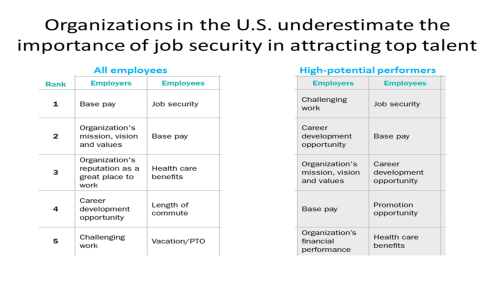
This was originally published on April 17, 2012. It’s worth repeating…
In doing some research for a speech I’m giving, I came across The Talent Management and Rewards Imperative for 2012 from Towers Watson and WorldatWork. It’s chock full of interesting data based on the 2011/2012 Towers Watson North American Talent Management and Rewards Survey and an unpublished Towers Watson 2011 survey of over 10,000 full-time employees in North America on topics such as total rewards, communication and other work-related issues. Because I’ve been looking at data about the state of the talent pipeline (see Data Points #3, #5, #6), I thought this would be interesting reading. Little did I know!
A couple of the data points that stood out to me challenge the “conventional wisdom.” See what you think:
- Only 11% of organizations have trouble retaining employees generally
- Fully 68% of organizations identify high potentials, but only 28% inform those employees who have been identified.
- Organizations underestimate the effect work-related stress and work/life balance have on employee retention, and do not recognized the significance of job security in attracting top talent.
Wait. What?
It’s the last point that brought me up short. Look at the chart below.
 There are important disconnects between what employees report will attract them into a new job and what employers believe will be important in attracting talent into their organizations. And if you look at the differing views between employers and high potential performers you’ll be even more surprised.
There are important disconnects between what employees report will attract them into a new job and what employers believe will be important in attracting talent into their organizations. And if you look at the differing views between employers and high potential performers you’ll be even more surprised.
In all of the writing on this topic that I have seen in the last 18 months, no one else reports the significant importance of job security as part of an organization’s EVP (employee value proposition). And look how it ranks as #1 for all employees as well as high-potential employees. #1.
Not meaningful work. Not alignment with the organization’s mission. Job security. Am I the only one surprised by this finding?
Look at the disconnect between the top 5 factors for all employees and employers’ top 5 factors. Outside of base pay it’s a total mismatch!
On the high-potential performers side, outside of base pay and career development opportunity it’s a total mismatch!
It looks like we’re totally out to lunch when it comes to knowing what’s motivating in terms of EVP and the talent pipeline. Out. To. Lunch.
In a world that observes the incredible talent acquisition strategies and investments at organizations like Zappos, PepsiCo, Rackspace and AT&T, we’re encouraged to believe that creating cultures of happiness and engagement are what it takes to delight customers and retain employees – high potential or otherwise. And I chose those organizations because I know the ground-breaking work each is doing in terms of building their talent communities and the engagement of their workforce. They truly are ground breaking.
It turns out talent attraction may be a bit more mundane than “creating a little weirdness.”
It turns out that some of the basics like job security and base pay still hold huge sway in our workforce. And I think this is good news. It gives” regular” employers doing good work and being good to their employees a fighting chance to keep their employees and attract the talent they’ll need going forward.
Basic blocking and tackling. Basic management competence. Basic HR. Can’t get away from them if you want your organization to succeed.





Interesting data China!
HR as a whole has a large set of demands to address – surely not limited to the more recently publicized approaches of organizations who are pushing the envelope in terms of corporate culture, mission, beliefs, etc…
Companies who bypass the basics for the sake of focusing on the buzz topics are putting a lot at risk. It’s similar to recruiters who have dismissed the basics and completely dedicate to social as the answer (the shiny tools). It may be exciting at first, but that wears off once the foundation of the practice crumbles.
Thanks for sharing!
Very interesting information! I’m not totally surprised that the employers list is so different from the employees list. But the fact that it is so markedly different is suprising.
I am not surprised however that after a few years or more of job insecurity to see job secuirty at the top of the list. I think since the tech bubble burst in the early 2000’s (and maybe even before that) companies have gone out of their way to stress that no job is really safe. This has become a mantra of employees and management and so i really do see why job security even a measure of assurance is very attractive to employees. I don’t think you have to be groundbreaking, and most companies will never be, to treat your employees well and make them feel valued and somewhat safe at work. That requires significant less effort than trying to be Zappos.